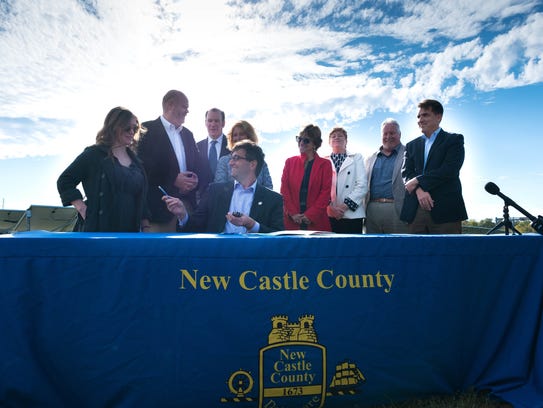A Connecticut commodities company is formalizing plans
to build a solar-panel array large enough to double the state's capacity
to generate power from the sun.
Freepoint Commodities, headquartered in Stamford,
Connecticut, has a contract to lease or purchase more than 400 acres that
are mostly farmland in southern New Castle County. It wants to turn that land
into the state's largest array of solar panels.
Peter Ford, managing director for Freepoint, declined to
identify the exact parcels under contract.
Four sit in New Castle
County within a mile and a half of the Cedar Creek Substation on Flemings
Landing Road east of Townsend. The other is nearby in Kent County, officials
said.
The properties are not contiguous but would tie into the
nearby substation forming a single facility, Ford said.
Together, the project would dwarf the state's largest solar
array, an 80-acre site near Milford. It would have the capacity to
generate 100 megawatts of energy, doubling the current 91 megawatt
capacity of all the state's arrays and home-mounted solar panels.
It's a lofty plan that faces several hurdles.
The first of those was the fact that New Castle County land
development rules up until Wednesday restricted large-scale solar energy
generating facilities on land zoned for industrial use.
Solar infrastructure is not uncommon in Delaware. The
state has 4,000 solar-energy generating systems, most of which augment
residential homes. The nine-largest solar arrays generate 40 percent
of the solar energy produced in the state.
Such large arrays are also not new to New Castle County. The
Christiana Mall has one, another sits off 7th Street in Wilmington and another
behind the car dealerships on East Cleveland Avenue in Newark.
Those are all meant to generate power for on-site use or are
situated on industrial land.
Industrially zoned land often comes with environmental
liabilities from past use and is less plentiful and more expensive than the
tens of thousands of acres of farmland south of the Chesapeake and Delaware
Canal.
Ford and his colleagues have been working with county
regulators for a year to take advantage of that.
On Wednesday, County Executive Matt Meyer signed legislation
that creates a new regulatory regime for developing such facilities, opening up
vast swaths of farmland and residential-zoned property.
"The bottom line is we are taking a major step forward
in something public officials like myself have been talking about for
years," Meyer said.
The bill was signed at a solar array on industrial land
owned by The Chemours Company off Del. 141 in Newport.
"Sites like this that are industrially zoned and have
space for solar are pretty rare," said Dale Davis, president of the
Delaware Solar Energy Coalition. "This new ordinance is going to change
that dramatically."
Ford said utility-scale solar arrays require big footprints.
There are not a lot of large industrial tracts remaining, he said.
The new rules allow for large facilities that sell power
back to the grid to be built in many different zoning categories.
The rules include provisions requiring the solar panels be
set 50 feet back from the property line and 150 feet back from homes. The
facilities must also be at least partially camouflaged by greenery.
Farmland in New Castle County is the target for
Freepoint.
The new rules limit total solar development to 1,000 acres
across the zoning category that encompasses most of the county's farmland. That
provision was added in response to concerns from County Council members who
fear the loss of farmland.
"What we have found is farmers are interested in this
because they are getting pressure squeezing their financial situation,"
said Richard Squadron, general counsel for Pennsylvania-based SunEast
Development, Freepoint's partner in the project. "This provides them a way
to make some financial gain by either leasing or selling their land and
ultimately it is still preserved for agriculture."
Utilities operating in Delaware are under state requirements
that 1.5 percent of the energy they sell this year be derived from solar power,
said Thomas Noyes, principal planner for utility policy at the Department
of Natural Resources and Environmental Control.
All utilities are on track to meet that goal, he said By
2025, state law requires 3.5 percent of the energy sold be derived from solar,
Noyes said.
"We are going to need more than (the Freepoint project)
to get to 3.5 percent," Noyes said.
With the development-regulation hurdle cleared, finding a
partner or partners to purchase the energy is the next step.
"We are on schedule to be under construction in
2019," Ford said. "The challenge we are still are facing is finding
customers."
Ford said his company wanted the project to be shovel ready
as it negotiates with utilities, potential government customers and private
entities like corporations and hospitals.
He said state mandates are important to make such projects
viable.
"What we have found in our other jurisdictions is that
it is a bit binary," Ford said. "When the customers come they come in
size and the come based on an initiative often promoted by the state and their
renewable targets."


No comments:
Post a Comment